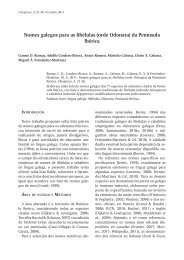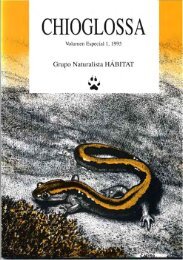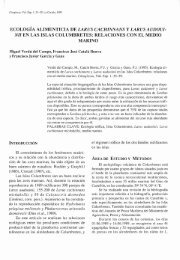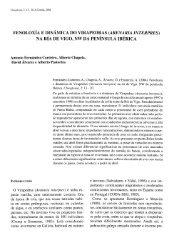1 Tr - Chioglossa
1 Tr - Chioglossa
1 Tr - Chioglossa
You also want an ePaper? Increase the reach of your titles
YUMPU automatically turns print PDFs into web optimized ePapers that Google loves.
20<br />
interesaban en sus cuadernos de campo. Durante el<br />
censo de 1991 se disfrutó de una ayuda económica,<br />
que sufragó parcialmente los gastos en los que incurrimos,<br />
concedida por la Consellería de Agricultura,<br />
Gandería e Montes de la Xunta de Galicia.<br />
SUMMARY<br />
Breeding status of the Peregrine Falcon (Falco peregrinus)<br />
in A CoruFia province (Calicia, NW Spain):<br />
population, distribution and threats<br />
The results of a census of the Peregrine Falcon's breeding<br />
population in A Coruña, at the extreme northwestern<br />
corner of the Iberian Peninsula, are presented<br />
in this paper. The census was carried out for the first<br />
time in 1991, being subsequently (partially) updated<br />
up to 1998. The most recent estimate gaves a total of<br />
34 breeding pairs (25 confinned, eight probable and<br />
one possible); this estimate was higher than the two<br />
preceeding ones. AII the nest ledges are located on<br />
rocky substrate: marine cliffs (1 1), riverine gullies<br />
(5), upland crags (2), abandoned stone quarries (5)<br />
and buildings (2). Minimum distance among occupied<br />
nest (2.5 km) and average distance for nest clusters<br />
(3.6 - 20 km) are much lower that those reported<br />
previously for the Hercinian stratum of the Iberian<br />
Peninsula (Heredia et al.. 1986). As far as we know,<br />
26 faleons were killed, injured or taken at the nest<br />
from 1986 to 1998 in the study area.<br />
Key words: A Coruña, breeding population, Fall'o<br />
peregrinus, northwest Spain. range. threats.<br />
BIBLIOGRAFÍA<br />
Anónimo (1975). Falcóns pelengríns na provincia da<br />
Coruña. Bubela. 2: 4.<br />
Anónimo ( 1986a). Mapa de los cultivos y aprovechamientos<br />
de la provincia de La CoruFia. Ministerio<br />
de Agricultura. Pesca y Alimentación. La<br />
Coruña.<br />
Anónimo (1986b). Newsletter (!f the World Working<br />
Croup on Birds ofPrey & Owls, 5: 6-8.<br />
Araújo. J. y Varela, 1. (1984). Las especies protegidas.<br />
Penthalón, Madrid.<br />
Bárcena. F. (1968). Anas crecca, especie nidificante<br />
en la Península Ibérica. Las Gándaras de Budiño.<br />
BraFia. 1: 94-107.<br />
CHIOGLOSSA. I (1999)<br />
Bartolomé. A. (1995). Aves nidificantes en la costa<br />
de Malpica (A Coruña). En 1. Munilla. y 1. Mouriño<br />
(Eds.): Actas do II Congreso Calego de<br />
Omitoloxía. págs. 175-182. Cursos e Congresos<br />
da Universidade de Santiago de Compostela n°<br />
90, Santiago de Compostela.<br />
Beebe, F.L. (1974). Field studies of the Falconiformes<br />
of British Columbia. B.e. Prov. Mus.<br />
Occas. Pap.• 17: 20-23.<br />
8ird, D. M. Y Aubry, Y. (1982). Reproductive and<br />
hunting behavior in falcons, Fall'O peregrinus. in<br />
Southern Quebec. Can. Fie/d-Nat., 96: 167-171.<br />
Castién, E. (1975). Sobor das rapiñas en Galicia.<br />
Sube/a, 2: 5-7.<br />
Cramp. S. y. Simmons. K.E.L (1980). The Birds (!f<br />
the Westem Paleartic. Vol. 2. Oxford University<br />
Press, Oxford.<br />
Doval. G. (1991). El expolio de nidos de Halcón<br />
Peregrino en la zona central de España. Quercus,<br />
62: 18-19.<br />
Enderson. J.H. y Kirvin. M.N. (1983). Flights of nesting<br />
peregrine falcons recorded by telemetry.<br />
Raptors Res.• 17: 33-37.<br />
Fernández-Cordeiro. A. y Domínguez, J. (Eds.)<br />
(1991). Actas do Primeiro Congreso Calego de<br />
Omitoloxía. Cursos e congresos da Universidade<br />
de Santiago de Compostela, n° 66, Santiago de<br />
Compostela.<br />
Gainzarain, J.A.• Arambarri, R. y Rodríguez, A.F.<br />
(1998). Censo, distribución, selección de hábitat<br />
de nidificación y tasas reproductoras del Halcón<br />
peregrino (Falco peregrinus) en Álava. Informe<br />
inédito.<br />
Garzón, J. (1973). Contribución al estudio del status,<br />
alimentación y protección de las Faleonifonnes<br />
en España Central. Ardeola, 19: 279-300.<br />
Gil Sánchez, J. M. (1999). Solapamiento de hábitat de<br />
nidificación y coexistencia entre el Águila-azor<br />
Perdicera (Hieraaetus fasciatus) y el Halcón<br />
Peregrino (Falco peregrinus) en un área de simpatría.<br />
Ardeola. 46: 31-38.<br />
Heredia. B., Delibes, J., Espina, J. y Máñez, M.<br />
(1984). Distribución y status de las faleoniformes<br />
en las zonas superiores a 1000 m en la provincia<br />
de Madrid. Rapinyaires Mediterranis, 2:<br />
190-202.<br />
Heredia, F.. Hiraldo F., González, L. M. Y González,<br />
J. L. (1988). Status, ecology and conservation of<br />
the Peregrine Faleon in Spain. En T. 1. Cade, 1.








